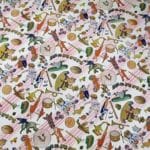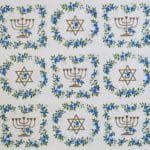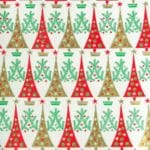That’s a Wrap!
by Jessica Kosinski
With the holiday season rapidly approaching, chances are good that you are stocking up on wrapping paper. After all, no matter which holiday you celebrate, you want the gifts you give to look their best. But did you ever wonder where the tradition of wrapping paper came from? Let’s take a peek at how wrapping paper came into being, and how wrapping trends have changed in different countries and across different cultures over the years.
The Origins and General Evolution of Wrapping Paper
In the 2nd century BC paper itself was invented in China, so it should come as no surprise that some of the earliest documented uses of paper to wrap gifts for holidays or special occasions can be traced to China and other Asian countries.
Of course, the paper invented in Ancient China was very different than today’s paper. The paper making process has evolved quite a bit throughout the centuries. In terms of wrapping paper, one of the biggest advancements came in England in 1890 when a process called flexography was patented. It involved a print cylinder being covered with a rubber plate. The effect was that large amounts of paper could be quickly printed in sheets or rolls, which of course is how many of us buy wrapping paper today, regardless of the occasion.
The Victorians as a group were known for their fancy, somewhat flamboyant style. Victorian furniture is especially easy to identify because of its ornate look. However, the Victorians were also very well known for their elaborate parties. Christmas was a particularly important time for them, and they soon began a tradition of giving Christmas cards to friends and family members.
As the practice of giving cards directly or mailing them at the holidays expanded, so too do the way in which the Victorians presented holiday gifts to loved ones. Thanks to British printing process improvements, they were able to start printing elaborate wrapping papers, which often times matched the holiday cards.
Father Christmas, holly boughs, and angels were all depicted on early Victorian gift wrap. So were robins. In the United States we primarily think of robins as a symbol for the coming of spring. However, English robins and American robins are two different bird types. English robins are often the only birds left that can be seen in winter there, which is one thing that led to them being a British symbol of winter and Christmas. As such, many early English wrapping paper designs, and even many designs today, include English robins.
Early U.S. Gift Wrapping Trends
The practice of using colorful holiday paper for either the holiday season or birthdays did not catch on as quickly here in the United States. Early U.S. gifts were primarily concealed in tissue paper or wrapped in plain brown paper. In fact, there were even early advertisements that proclaimed brown paper as being the best way to wrap gifts. One theory was that more elaborate wrapping materials would take away from the gift itself. In other words, the package would be more interesting than the present.
Early U.S. gift wrapping trends took a turn for the more elaborate in 1917 in Kansas City, Missouri. Two brothers named Rollie and Joyce Hall had a stationary store there at the time. They had a practice of selling tissue paper around the holiday season, but business was so good that year that they ran completely out of it. As an alternative, they began selling paper usually meant for lining the insides of envelopes for ten cents per sheet. It was such a success that they continued the trend the following year.
Rollie and Joyce Hall soon realized that they could print their own paper with holiday designs on it specifically for the purpose of wrapping Christmas presents. In 1919 they started doing just that, and soon their stationary store in Kansas City grew into one of the most recognizable store chains in the United States today, Hallmark. For those who love early retro U.S. wrapping paper, few things are more exciting than coming across wrapping paper made by the Hall brothers in the early years of U.S. gift wrap.
Wrapping paper has evolved to feature different pictures during different time periods. For example, the 1930s Art Deco movement saw the introduction of images like ice skates and snow flakes on gift wrap, whereas 1950s and 1960s gift wrap often used actual photographic prints as decoration. Another major change came in the 1970s when film producers began depicting their film characters on gift wrap.
Uses for Vintage and Retro Wrapping Paper Today
Early wrapping paper today has a lot of historical and cultural significance, depending on where and when it was made. You can learn a lot about a time period or a culture by looking at it. For example, St. Nick, Father Christmas, Santa Claus and other incarnations of the jolly fellow who gives gifts around the holidays have been depicted in different ways on wrapping paper from various years and across the different countries. So, it’s almost like you can see how the figure has evolved by collecting wrapping paper from different time periods.
Some people also use vintage or retro gift wrap during the holiday season as a way to honor the spirits of family members who have passed away or recreate memories from when they were young. Wrapping paper from bygone days can also be a huge hit at holiday parties in nursing homes or elderly housing facilities where residents might enjoy seeing a part of their childhood.
Another reason to use older gift wrap is if you plan to hold a holiday party with a theme based around a certain era. Having gift wrap from that era can add to the realism of the event, making your party a huge success.
Regardless of why you want to find wrapping paper or the era of wrapping paper you are interested in, there are several ways to go about the process. Obviously antiques shops, flea markets, and yard sales can be good places to look, but the internet may offer more instant gratification. Websites like eBay and Etsy constantly have wrapping paper from different cultures and time periods available. You can also easily obtain reproduction wrapping paper in vintage or retro styles online. So, whether you have a love of holiday history or just want to have a nostalgic holiday season this year, wrapping your gifts in paper from years gone by is a great way to start.
Jessica Kosinski has been a freelance writer specializing in writing short articles for 15 years. She is also an avid collector of both antique books and Star Wars memorabilia. Although she is not in the antiques industry professionally, she has learned a lot about antiques over the years by periodically helping out at her mom’s antiques shop in Greenville, NH. She currently balances maintaining the antiques shop’s Facebook page, www.facebook.com/MallofNE, and working on various freelance writing assignments. She can be reached at dementorskiss77@yahoo.com.

















Related posts: